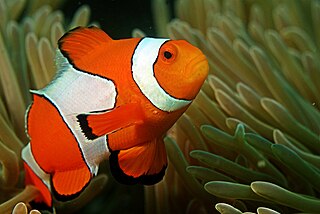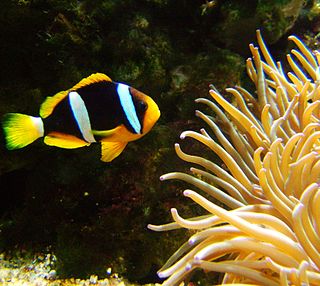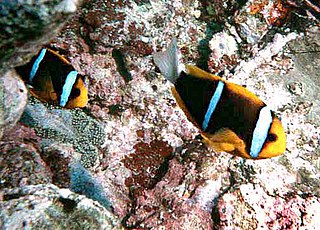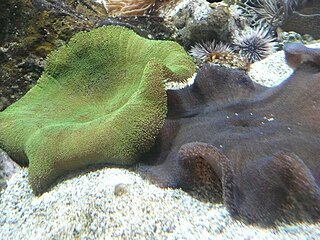
Clownfish or anemonefish are fishes from the subfamily Amphiprioninae in the family Pomacentridae. Thirty species are recognized: one in the genus Premnas, while the remaining are in the genus Amphiprion. In the wild, they all form symbiotic mutualisms with sea anemones. Depending on species, anemonefish are overall yellow, orange, or a reddish or blackish color, and many show white bars or patches. The largest can reach a length of 17 cm (6.7 in), while the smallest barely achieve 7–8 cm (2.8–3.1 in).

Amphiprion clarkii, known commonly as Clark's anemonefish and yellowtail clownfish, is a marine fish belonging to the family Pomacentridae, the clownfishes and damselfishes.

Heteractis magnifica, also known by the common names magnificent sea anemone or Ritteri anemone, is a species of sea anemone belonging to the Stichodactylidae family native to the Indo-Pacific area.

Amphiprion sandaracinos, also known as the orange skunk clownfish or orange anemonefish, is a species of anemonefish that is distinguished by its broad white stripe along the dorsal ridge. Like all anemonefishes it forms a symbiotic mutualism with sea anemones and is unaffected by the stinging tentacles of the host anemone. It is a sequential hermaphrodite with a strict sized based dominance hierarchy: the female is largest, the breeding male is second largest, and the male non-breeders get progressively smaller as the hierarchy descends. They exhibit protandry, meaning the breeding male will change to female if the sole breeding female dies, with the largest non-breeder becomes the breeding male.

The sebae anemone, also known as leathery sea anemone, long tentacle anemone, or purple tip anemone, is a species of sea anemone belonging to the family Stichodactylidae and native to the Indo-Pacific area.

Bubble-tip anemone is a species of sea anemone in the family Actiniidae. Like several anemone species, E. quadricolor can support several anemonefish species, and displays two growth types based on where they live in the water column, one of which gives it the common name, due to the bulbous tips on its tentacles.

The orange-fin anemonefish is a marine fish belonging to the family Pomacentridae, the clownfishes and damselfishes, found in the Western Pacific north of the Great Barrier Reef from the surface to 20 m, to include the Pacific Ocean between Queensland, Australia, and New Guinea to the Marshall and Tuamotus Islands. It can grow to 17 cm in length.

Amphiprion polymnus, also known as the saddleback clownfish or yellowfin anemonefish, is a black and white species of anemonefish with a distinctive saddle. Like all anemonefishes it forms a symbiotic mutualism with sea anemones and is unaffected by the stinging tentacles of the host anemone. It is a sequential hermaphrodite with a strict sized-based dominance hierarchy: the female is largest, the breeding male is second largest, and the male non-breeders get progressively smaller as the hierarchy descends. They exhibit protandry, meaning the breeding male will change to female if the sole breeding female dies, with the largest non-breeder becomes the breeding male.

Amphiprion akindynos, the Barrier Reef anemonefish, is a species of anemonefish that is principally found in the Great Barrier Reef of Australia, but also in nearby locations in the Western Pacific. The species name 'akindynos' is Greek, meaning 'safe' or 'without danger' in reference to the safety afforded amongst the tentacles of its host anemone. Like all anemonefishes it forms a symbiotic mutualism with sea anemones and is unaffected by the stinging tentacles of the host anemone. It is a sequential hermaphrodite with a strict size-based dominance hierarchy: the female is largest, the breeding male is second largest, and the male non-breeders get progressively smaller as the hierarchy descends. They exhibit protandry, meaning the breeding male will change to female if the sole breeding female dies, with the largest non-breeder becomes the breeding male. The fish's natural diet includes zooplankton.

Amphiprion bicinctus, meaning "both sawlike with two stripes," commonly known as the Red Sea or two-bandedanemonefish is a marine fish belonging to the family Pomacentridae, the clownfishes and damselfishes. Like other species of the genus, the fish feeds on algae and zooplankton in the wild.

Amphiprion perideraion also known as the pink skunk clownfish or pink anemonefish, is a species of anemonefish from the skunk complex that is widespread from northern Australia through the Malay Archipelago and Melanesia. Like all anemonefishes, it forms a symbiotic mutualism with sea anemones and is unaffected by the stinging tentacles of the host. It is a sequential hermaphrodite with a strict size-based dominance hierarchy; the female is largest, the breeding male is second largest, and the male nonbreeders get progressively smaller as the hierarchy descends. They exhibit protandry, meaning the breeding male changes to female if the sole breeding female dies, with the largest nonbreeder becoming the breeding male.
The three-band anemonefish is a species of anemonefish endemic to the Marshall Islands in the western part of the Pacific Ocean. Like all anemonefishes, it forms a symbiotic mutualism with sea anemones and is unaffected by the stinging tentacles of its host. It is a sequential hermaphrodite with a strict size-based dominance hierarchy; the female is largest, the breeding male is second largest, and the male nonbreeders get progressively smaller as the hierarchy descends. They exhibit protandry, meaning the breeding male changes to female if the sole breeding female dies, with the largest nonbreeder becoming the breeding male. The fish's natural diet includes zooplankton.

Stichodactyla haddoni, commonly known as Haddon's sea anemone, is a species of sea anemone belonging to the family Stichodactylidae. It is found in the Indo-Pacific area.

Stichodactyla mertensii, commonly known as Mertens' carpet sea anemone, is a species of sea anemones in the family Stichodactylidae. It is regarded as the largest sea anemone with a diameter of over 1 m (3.3 ft), the next largest being Heteractis magnifica, which has longer tentacles. This species has an oral disc that can be described as more ovoid than circular that contours to the surrounding substrate and is attached to the substrate by adhesive verrucae, which are wart-like projections. Its blunt or pointed tentacles are uniformly shaped, and are only about 1–2 centimetres (0.39–0.79 in) long. It contains obligate symbiotic zooxanthellae, and is a host to around half the species of anemonefish and one damselfish, Dascyllus trimaculatus.

Heteractis aurora is a species of sea anemone in the family Stichodactylidae.

Macrodactyla doreensis, common names long tentacle anemone and corkscrew tentacle sea anemone, is a species of sea anemone in the family Actiniidae.

Cryptodendrum is a genus of sea anemones in the family Thalassianthidae. It is monotypic with a single species, Cryptodendrum adhaesivum, also commonly known as the adhesive anemone, pizza anemone, and nap-edged anemone. Like all symbiotic anemones it hosts zooxanthellae, symbiotic algae that help feed their host.

Amphiprion chrysogaster, the Mauritian anemonefish, is a marine fish belonging to the family Pomacentridae, the clownfishes and damselfishes. It is endemic to Mauritius and probably Réunion.

Amphiprion leucokranos is a naturally occurring hybrid anemonefish found in the western central Pacific Ocean. Like all anemonefishes it forms a symbiotic mutualism with sea anemones and is unaffected by the stinging tentacles of the host anemone. It is a sequential hermaphrodite with a strict dominance hierarchy, features which are critical to the direction of gene flow.
Amphiprion pacificus, is a species of anemonefish that is found in the western Pacific Ocean. Like all anemonefishes it forms a symbiotic mutualism with sea anemones and is unaffected by the stinging tentacles of the host anemone. It is a sequential hermaphrodite with a strict sized based dominance hierarchy: the female is largest, the breeding male is second largest, and the male non-breeders get progressively smaller as the hierarchy descends. They exhibit protandry, meaning the breeding male will change to female if the sole breeding female dies, with the largest non-breeder becomes the breeding male. The fish's natural diet includes zooplankton.


















